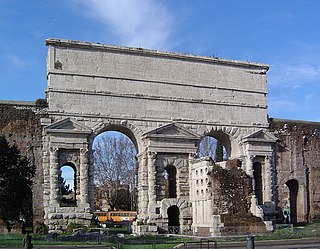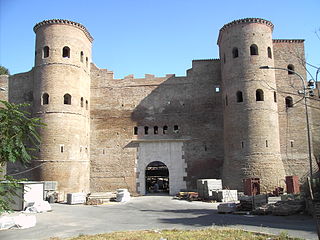
The Via Salaria was an ancient Roman road in Italy. It eventually ran from Rome to Castrum Truentinum on the Adriatic coast, a distance of 242 km. The road also passed through Reate (Rieti) and Asculum.

The Via Aurelia is a Roman road in Italy constructed in approximately 241 BC. The project was undertaken by Gaius Aurelius Cotta, who at that time was censor. Cotta had a history of building roads for Rome, as he had overseen the construction of a military road in Sicily connecting Agrigentum and Panormus.

The Porta Maggiore, or Porta Prenestina, is one of the eastern gates in the ancient but well-preserved 3rd-century Aurelian Walls of Rome. Through the gate ran two ancient roads: the Via Praenestina and the Via Labicana. The Via Prenestina was the eastern road to the ancient town of Praeneste. The Via Labicana heads southeast from the city.

The Gardens of Sallust was an ancient Roman estate including a landscaped pleasure garden developed by the historian Sallust in the 1st century BC. It occupied a large area in the northeastern sector of Rome, in what would become Region VI, between the Pincian and Quirinal hills, near the Via Salaria and later Porta Salaria. The modern rione is now known as Sallustiano.

Porta Tiburtina or Porta San Lorenzo is a gate in the Aurelian Walls of Rome, Italy, through which the Via Tiburtina exits the city.

Castra Praetoria were the ancient barracks (castra) of the Praetorian Guard of Imperial Rome.

The Porta Esquilina was a gate in the Servian Wall, of which the Arch of Gallienus is extant today. Tradition dates it back to the 6th century BC, when the Servian Wall was said to have been built by the Roman king Servius Tullius. However modern scholarship and evidence from archaeology indicate a date in the fourth century BC. The archway of the gate was rededicated in 262 as the Arch of Gallienus.

Porta Salaria was a gate in the Aurelian Walls of Rome, Italy. Constructed between 271 AD and 275 AD, it was demolished in 1921.

Porta Pinciana is a gate of the Aurelian Walls in Rome.

The Porta Latina is a single-arched gate in the Aurelian Walls of ancient Rome.

The Tomb of the Scipios, also called the hypogaeum Scipionum, was the common tomb of the patrician Scipio family during the Roman Republic for interments between the early 3rd century BC and the early 1st century AD. Then it was abandoned and within a few hundred years its location was lost.

The Porta Asinaria is a gate in the Aurelian Walls of Rome. Dominated by two protruding tower blocks and associated guard rooms, it was built between 271 and 275 AD, at the same time as the Wall itself. It was not rebuilt or fortified in the time of Honorius and not restored by Theoderic as most of the other gates.

Via Asinaria was an ancient Roman road that started from Porta Asinaria in the Aurelian walls (Rome). It was somehow connected with the Via Latina, as it is reported that Belisarius, during its advance on Rome, left the Via Latina to enter the city from Porta Asinaria; the latter was considered one of the main accesses for those coming from the south, as in ancient times the 17th-century Porta San Giovanni didn't exist.

The Pons Probi was a bridge over the River Tiber in Ancient Rome, just south of Porta Trigemina.

The Arch of Dolabella and Silanus or Arch of Dolabella is an ancient Roman arch. It was built by senatorial decree in 10 AD by the consuls P. Cornelius Dolabella and C. Junius Silanus.

Porta Ardeatina was one of the gates of the Aurelian Walls in Rome (Italy).

The Regio I Porta Capena is the first regio of imperial Rome, under Augustus's administrative reform. Regio I took its name from the Porta Capena, a gate of the Servian Walls, through which the Appian Way entered the city prior to the construction of the Aurelian Walls.

The Regio II Caelimontium is the second regio of imperial Rome, under Augustus's administrative reform. It took its name from the Caelian Hill, which the region was centred on.

The Regio VI Alta Semita is the sixth regio of imperial Rome, under Augustus's administrative reform. Regio VI took its name from the street passing over the Quirinal Hill. It was a large regio that also encompassed the Viminal Hill, the lower slopes of the Pincian, and the valleys in-between.

The Regio XII Piscina Publica is the twelfth regio of imperial Rome, under Augustus's administrative reform. Regio XII took its name from the Piscina Publica, a swimming pool that disappeared during the middle imperial period.























